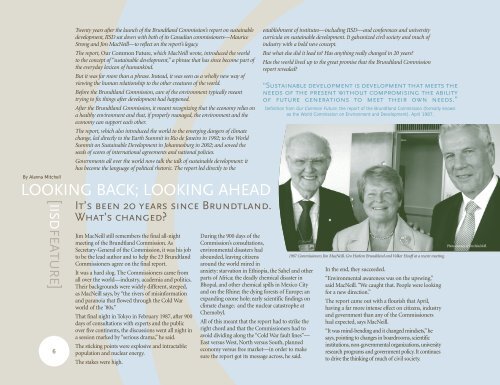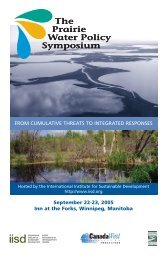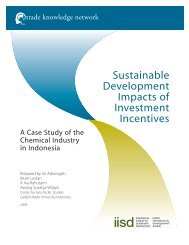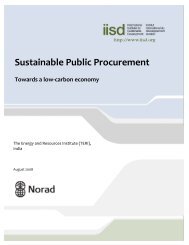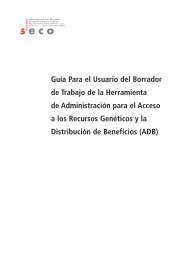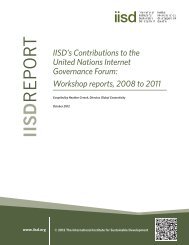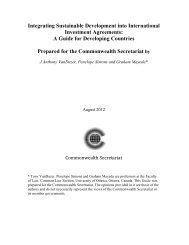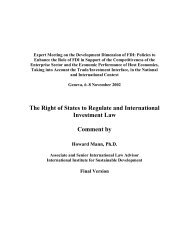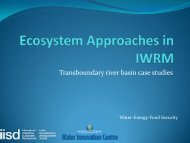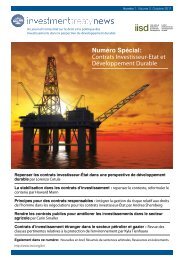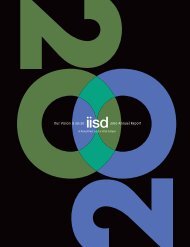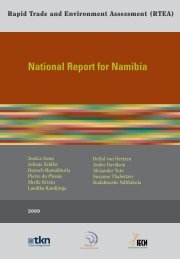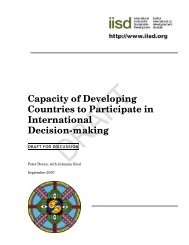2006/2007 Annual Report - International Institute for Sustainable ...
2006/2007 Annual Report - International Institute for Sustainable ...
2006/2007 Annual Report - International Institute for Sustainable ...
Create successful ePaper yourself
Turn your PDF publications into a flip-book with our unique Google optimized e-Paper software.
By Alanna Mitchell<br />
LOOKING BACK; LOOKING AHEAD<br />
[IISDFEATURE]<br />
6<br />
Twenty years after the launch of the Brundtland Commission’s report on sustainable<br />
development, IISD sat down with both of its Canadian commissioners—Maurice<br />
Strong and Jim MacNeill—to reflect on the report’s legacy.<br />
The report, Our Common Future, which MacNeill wrote, introduced the world<br />
to the concept of “sustainable development,” a phrase that has since become part of<br />
the everyday lexicon of humankind.<br />
But it was far more than a phrase. Instead, it was seen as a wholly new way of<br />
viewing the human relationship to the other creatures of the world.<br />
Be<strong>for</strong>e the Brundtland Commission, care of the environment typically meant<br />
trying to fix things after development had happened.<br />
After the Brundtland Commission, it meant recognizing that the economy relies on<br />
a healthy environment and that, if properly managed, the environment and the<br />
economy can support each other.<br />
The report, which also introduced the world to the emerging dangers of climate<br />
change, led directly to the Earth Summit in Rio de Janeiro in 1992; to the World<br />
Summit on <strong>Sustainable</strong> Development in Johannesburg in 2002; and sowed the<br />
seeds of scores of international agreements and national policies.<br />
Governments all over the world now talk the talk of sustainable development: it<br />
has become the language of political rhetoric. The report led directly to the<br />
It’s been 20 years since Brundtland.<br />
What’s changed?<br />
Jim MacNeill still remembers the final all-night<br />
meeting of the Brundtland Commission. As<br />
Secretary-General of the Commission, it was his job<br />
to be the lead author and to help the 23 Brundtland<br />
Commissioners agree on the final report.<br />
It was a hard slog. The Commissioners came from<br />
all over the world—industry, academia and politics.<br />
Their backgrounds were widely different, steeped,<br />
as MacNeill says, by “the rivers of misin<strong>for</strong>mation<br />
and paranoia that flowed through the Cold War<br />
world of the ’80s.”<br />
That final night in Tokyo in February 1987, after 900<br />
days of consultations with experts and the public<br />
over five continents, the discussions went all night in<br />
a session marked by “serious drama,” he said.<br />
The sticking points were explosive and intractable:<br />
population and nuclear energy.<br />
The stakes were high.<br />
During the 900 days of the<br />
Commission’s consultations,<br />
environmental disasters had<br />
abounded, leaving citizens<br />
around the world mired in<br />
anxiety: starvation in Ethiopia, the Sahel and other<br />
parts of Africa; the deadly chemical disaster in<br />
Bhopal, and other chemical spills in Mexico City<br />
and on the Rhine; the dying <strong>for</strong>ests of Europe; an<br />
expanding ozone hole; early scientific findings on<br />
climate change; and the nuclear catastrophe at<br />
Chernobyl.<br />
All of this meant that the report had to strike the<br />
right chord and that the Commissioners had to<br />
avoid dividing along the “Cold War fault lines”—<br />
East versus West, North versus South, planned<br />
economy versus free market—in order to make<br />
sure the report got its message across, he said.<br />
establishment of institutes—including IISD—and conferences and university<br />
curricula on sustainable development. It galvanized civil society and much of<br />
industry with a bold new concept.<br />
But what else did it lead to? Has anything really changed in 20 years?<br />
Has the world lived up to the great promise that the Brundtland Commission<br />
report revealed?<br />
“<strong>Sustainable</strong> development is development that meets the<br />
needs of the present without compromising the ability<br />
of future generations to meet their own needs.”<br />
Definition from Our Common Future, the report of the Brundtland Commission (<strong>for</strong>mally known<br />
as the World Commission on Environment and Development), April 1987.<br />
1987 Commissioners Jim MacNeill, Gro Harlem Brundtland and Volker Hauff at a recent meeting.<br />
In the end, they succeeded.<br />
“Environmental awareness was on the upswing,”<br />
said MacNeill. “We caught that. People were looking<br />
<strong>for</strong> a new direction.”<br />
The report came out with a flourish that April,<br />
having a far more intense effect on citizens, industry<br />
and government than any of the Commissioners<br />
had expected, says MacNeill.<br />
“It was mind-bending and it changed mindsets,” he<br />
says, pointing to changes in boardrooms, scientific<br />
institutions, non-governmental organizations, university<br />
research programs and government policy. It continues<br />
to drive the thinking of much of civil society.<br />
Photo courtesy of Jim MacNeill.


